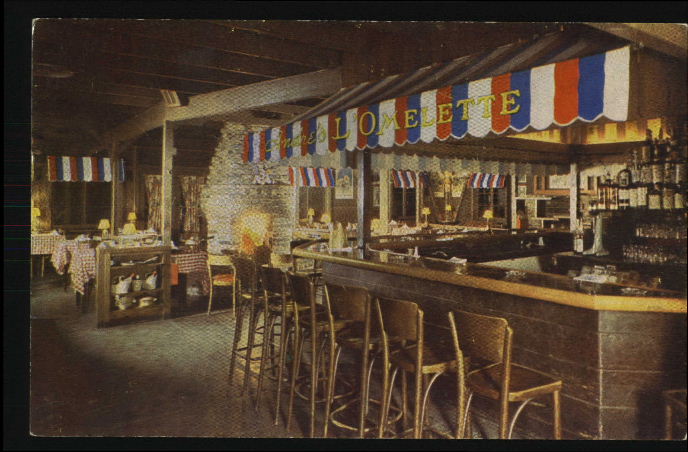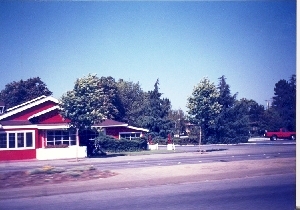Restaurant Row: Good 'Ol Palo Alto Cookin'
Set out on any major American highway these days and your choices for lunch are pretty limited. Unless you want to forgo making “good time”, your roadside options usually consist of six fast food logos arranged neatly on a blue “Gas Food Lodging” sign. And with rare exception the choicesdo not stray very far from some combination of Taco Bell, McDonalds, KFC, and the like. Down South you may find a few more Hardee’s and out here you might see an In-N-Out or two, but a highway lunch is going to pretty much consist of something deep fried and coming through your car window in a white paper bag.
But there was a time when the eating possibilities on the American roadway were an essential part of what it meant to travel, when the array of cuisines and restaurants that each community offered was part of the tapestry of the trip. Back then the roads most travelled were not anonymous Interstates but distinctive state highways, and the landscape was dotted with fancy restaurants, rickety old hot dog stands and occasionally a diamond in the roadside rough.
In the years after World War II and well into the 1970s, El Camino Real in Palo Alto was one of those highways. As old US 101, El Camino was a main road leading from San Francisco to San Jose --- and as such, it was a kind of showcase for restaurants vying to fill the stomachs of hungry travelers.
The stretch of El Camino in southern Palo Alto was a convenient and popular locale for roadside restaurants that wished to avoid strict liquor laws. State laws passed after prohibition banned hard alcohol sales within a mile and a half from college campuses such as Stanford. As a result, dinner couples, highway travelers and university students in search of a drink all frequented Restaurant Row on the old King’s Highway.
Three of the most storied of these restaurants were owned at one time by the same man --- the venerable restaurateur and hotel wiz, John Rickey. Rickey’s Studio Inn, Rick’s Swiss Chalet and Dinah’s Shack (bought by Rickey in 1950) were all well-known stops for Highway 101 travelers. And they demonstrated
the great variety of cuisines that could be found on one road.
Dinah’s Shack began in the late ‘20s as a Southern style chicken-on-toast stand --- to which Rickey later added the scores of appetizers to be found in the famed Scandinavian smorgasbord. Rick’s Swiss Chalet was geared specifically to the food and tastes of the owner’s native Switzerland and provided European ambiance, courtesy of Southern Bavaria’s Edelweiss Trio. The Chalet hosted the first meeting of the still-active Peninsula Swiss Club. From 1961-1985, the restaurant served some 3 million meals on El Camino Way where the Goodwill store now stands.
Rickey’s Studio Club became a local hot spot in the 1950s and for more reasons than just Mrs. Rickey’s secret-recipe cheesecake. The cuisine was admired throughout the northern part of the state and its dining room featured paintings from Rickey’s vast (and rather expensive) art collection.
Other options along Restaurant Row provided international flavors from all over the world. Chinese Chicken Salad and other tastes of the Orient could be found at Ming’s Chinese Restaurant at the corner of El Camino and Vista Road (Ming’s moved to its current location off Embarcadero Road in 1967). Fine French cuisine thrived just off El Camino at Villa Lafayette --- home to chef Adrien Jouan, who had started cooking as a 10-year-old apprentice in Paris.
In 1956, brothers Harry, Rudy, George and Art Alfinito opened the beloved Rudolpho’s at the corner of Los Robles Avenue and El Camino. The brothers would spend more than three decades serving cannelloni to Jimmy Durante and other not-so-famous clientele at their distinctive red-checkered tables. In 1993, the restaurant was closed and later bulldozed to make way for apartments after the City Council changed the zoning status of the block --- a controversial action that brought angry protests from spaghetti fans all over Barron Park.
Aside from fine dining, Restaurant Row provided Palo Alto with its share of the 1950’s drive-in experience, forever memorialized nationally in American Graffiti and Happy Days. Restaurant Row had a number of drive-ins including the John Barnes Drive-In, the Carousel and Bonander’s --- as well as an A&W franchise. After its move from Middlefield Road, the A&W became a rare chain eatery along the largely independently-owned Restaurant Row.
The drive-ins were, of course, a prime social hangout for teenagers before the days of big indoor malls. Slicked back boys and their poodle-skirted dates would pull up at parking stalls fitted with speakers to order Mama or Papa Burgers, Chili Dogs and 11-cent French fries. Brightly attired carhops zipped out the food, allowing the kids to remain in their car to eat “on the drive.” Indeed, this was the beginning of the drive-in era which included the popular practice which seems a bit odd these days --- watching a full-length movie from a vantage point behind your windshield.
Of course, the drive-in restaurants tended to attract a different crowd from the sit-down options along Restaurant Row. While the Rickey’s restaurants generally appealed to travelling families or those in search of a martini with dinner, the drive-ins attracted high school locals. In 1966, the A&W which stood at 4127 El Camino Real (the current site of the Tofu House) became the subject of city council inquiries when neighbors complained of drunken rowdiness, burning rubber and “uncontrolled pandemonium.” A police crackdown quieted down the kids but also brought some 31 citations in less than a month.
While there have been some independent success stories during the past few decades, including Hobee’s (“home of the famous coffeecake”) and Jose’s Caribbean Restaurant (which for a while advertised their “worst pizza in town”), the old legends of Restaurant Row are long gone. They were the victims of a number of changes --- competition from the chic restaurants that have thrived downtown since liquor laws were lifted, the diversion of travelers out to Bayshore Freeway, zoning changes and an abundance of fast-food drive-thrus which further serve a culture that is “on the drive.”
The last of the great old restaurants of Restaurant Row came down in 1995. It was known for years as L’Omelette, a cozy, wood-paneled restaurant that looked something like a French farmhouse. Legend has it that in 1940, Jack Kennedy, while on a brief stint at Stanford Business School, held court at a certain L’Ommies barstool surrounded by a regular throng of groupies.
Having thrived through the ‘50s and ‘60s, L’Omellette stumbled during the '70s untilFrench chef Louis Borel took it over, revived it, and in 1981 renamed it Chez Louis. There he entertained the likes of Joan Baez, Bill Walsh and Hewlett and Packard. But after 20 years, the old master could no longer compete with downtown and the chain restaurants that had
closed in on him. As Borel told the San Francisco Chronicle with a tear, “It doesn't fit. You can't make it fit. It is a restaurant from another era.” In 1995, the old place finally came down, bulldozed to make way for the Walgreen’s that stands there now. For Restaurant Row, it was the last supper, as time --- and California’s highway travelers --- had long passed it by. []
Our Reader's Memories:
"There was a New Orleans style restaurant on E.C.R.. As I recall,it would have been on the west side, between Rudolfo's and Charleston. It was there in the '50s. It was home style, white table cloths and waiters. The food was excellent and the restaurant was small. I remember eating there as a child when my grandparents visited us on their annual trip from Miami. I can't remember the name now. Last week I could have told you...Who can't remember Stickney's Hickory House at Town and Country Village. Joe Greer gave horse drawn wagon rides. Stickney's also had a 24hr. place on E.C.R. just south of Varian. The
place has gone through many incarnations since then. Thanks for listening."
-Daniel.
"Saco's restaurant --- mid-eighties:My mom used to send me down to Saco's to pick up some dinner for the family: chicken and pasta that Saco would cook right then and there in her little stall. A bit oily, but always delicious!"
"I worked as a busboy for Rudolpho's in 1974 - 1976. I remember the colorful arguments the brothers would have - shouting at each other in Italian. Each brother had their own role. George was the main chef and the funniest. Harry was the bartender - and raised eyebrows when he (at near 50 years old) married one of the very young and beautiful cocktail waitresses. But Harry deserved her - he was kind, smart, and the peacemaker in the family. Art was the "manager" who thought he was the Maitre d' at Le Cirque in NYC - overseeing the whole operation. I don't remember him working very hard."
-Ed
Bay area native here :) I grew up in Santa Cruz & Redwood City and have lived in Menlo Park many years now. I recently came across an old glass ashtray in a thrift shop: Rickey's, with a festive cocktail logo, above it says "Town House San Francisco" & below "Studio Club Palo Alto" ...Couldn't pass it up, I am a collector of the era and love finding bay area/fun little souveniers from days past. Thank you for this history - I really enjoyed reading this/getting the story behind my little ashtray which is now displayed in my curio cabinet. Love the photos too! :) Vanessa
"I remember the harp playing and all I could eat shrimp at the salad bar. Steaks were grand! Absolutely the best dining experiences with my mom and dad. We went there a lot." -Michelle
"I remember Delmonico's restaurant. It was my FAVORITE! It was like dining in someone's home, complete with lit fireplace and a small dance floor. Does anyone remember it's exact location, and when it closed?" -Tanya
Send Us Your Memory!


Inside at Rick's Swiss Chalet.

Rickey's on El Camino.

The Bar at L'Ommies.

Restaurant and hotel genius John Rickey. (PAHA)

Dinah's Shack in the 1980s.

Dinah's Shack in its early years. (PAHA)